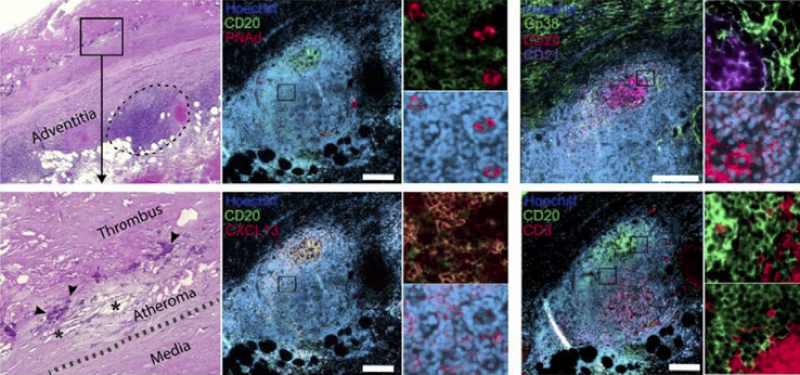Control of the Tfh-GC B Cell Axis by CD8+ Tregs Limits Atherosclerosis and Tertiary Lymphoid Organ Development
Clement M, Guedj K, Andreata F, Morvan M, Bey L, Khallou-Laschet J, Gaston AT, Delbosc S, Alsac JM, Bruneval P, Deschildre C, Le Borgne M, Castier Y, Kim HJ, Cantor H, Michel JB, Caligiuri G, Nicoletti A
2015 • Circulation • [pdf] • Editorial
BACKGROUND: -The atheromodulating activity of B cells during the development of atherosclerosis is well documented, but the mechanisms by which these cells are regulated have not been investigated.
METHODS AND RESULTS: -Here, we analyzed the contribution of Qa-1-restricted CD8+ regulatory T cells (CD8+ Tregs) to the control of the T follicular helper (Tfh)-germinal center (GC) B cell axis during atherogenesis. Genetic disruption of CD8+ Treg function in atherosclerosis-prone apolipoprotein E knockout (ApoE degrees ) mice resulted in overactivation of this axis in secondary lymphoid organs (SLOs), led to the increased development of tertiary lymphoid organs (TLOs) in the aorta, and enhanced disease development. In contrast, restoring control of the Tfh-GC B cell axis by blocking the ICOS-ICOSL pathway reduced the development of atherosclerosis and the formation of TLOs. Moreover, an analysis of human atherosclerotic aneurysmal arteries by flow cytometry, gene expression analysis, and immunofluorescence confirmed the presence of Tfh cells within TLOs.
CONCLUSIONS: -This study is the first to demonstrate that the Tfh-GC B cell axis is pro-atherogenic and that CD8+ Tregs control the GC reaction in both SLOs and TLOs. Therefore, disrupting this axis represents an innovative therapeutic approach.


